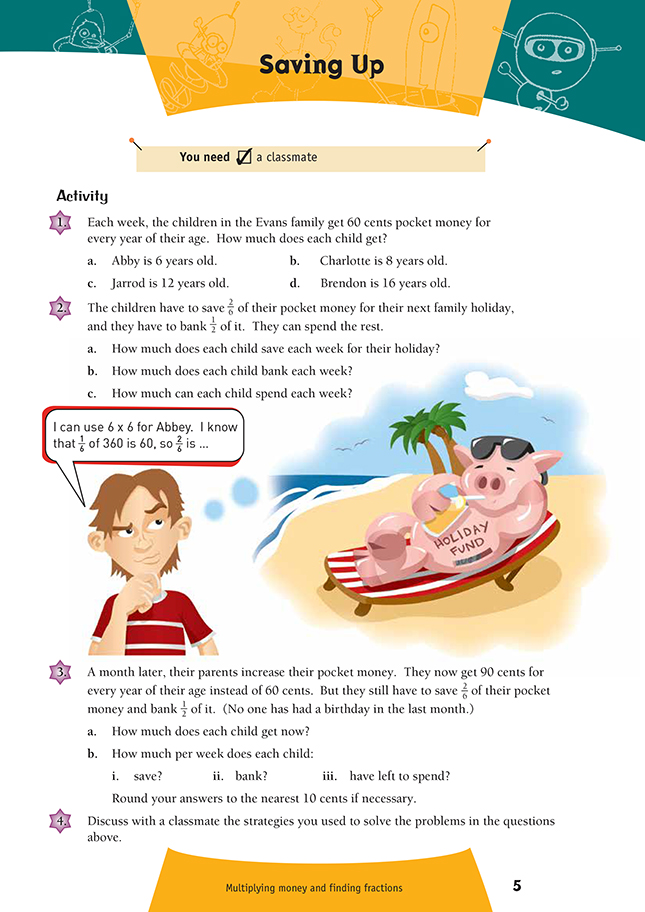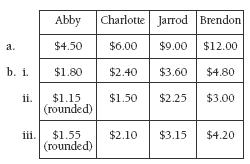This is a level 3 number activity from the Figure It Out series. It relates to Stage 6 of the Number Framework.
A PDF of the student activity is available.
Click on the image to enlarge it. Click again to close. Download PDF (213 KB)
find fractions of money
FIO, Level 3, Number, Book 2, Saving Up, page 5
A classmate
This activity looks at finding a fraction of a set in a money context. The fractions involved are 1/2, 1/4, 2/5, and possibly 1/5 and 3/4. Note the progression from unit fractions with a numerator of 1, starting with 1/4, to 2/5, which has a numerator of 2. The strategies that the students use to handle this progression are the key learning intention here. The strategy illustrated in the speech bubble shows the beginning of proportional thinking.
Question 1 may be solved by multiplying 50 cents by the number of years and then converting the cents to dollars. You could encourage the students to see the 50 cents as ½ a dollar by asking questions such as:
“Can you multiply by 50 cents without multiplying by 50?”
“Instead of multiplying by 50 cents, can you solve the problem by dividing by another number?”
Question 2 can be solved in at least two ways. The students can solve 2/5 by finding 1/5 of the total and then multiplying by 2, as shown in the speech bubble. Another way is to find 2/5 of $1 or 100 cents and then see how many of these units make up the targeted amount. For example, 2/5 of $1 is 40 cents, and as Abby gets $3, she must put aside 3 lots of 40 cents, which is $1.20.
There are various strategies that can be used to answer question 3a. For example, the students could think of 75 cents as ¾ of a dollar and then multiply the ages by ¾. They could also solve it by multiplying the age by 75 and then converting that to dollars and cents. Note that Abby’s answer in 3b ii has to be rounded because the exact calculation is $1.125 cents, which is not realistic. We suggest rounding up to $1.15 because $1.125 rounds to $1.13, and the nearest 5 cent multiple is $1.15. (This leaves her $1.55 to spend.)
The students may realise that the children have had their pocket money increased by half because 75 cents is 50 cents plus 25 cents. So all the saving and banking will increase by half. For example, Abby’s holiday savings are now $1.20 + 60c = $1.80.
Encourage the students to look for a proportional connection between the two rates of pocket money as opposed to an additive one, such as “the rate is 25 cents more than before”.
As an extension, you could ask the students to find amounts of pocket money given after 5 weeks, 3 months, 1/6 of a year, and so on. Choose units that suit the level of the students.
Answers to Activity
1. a. $3
b. $4
c. $6
d. $8
2. (Note: of $1 is 40c, and of $1 is 25c.)
Abby a. $1.20 b. 75c c. $1.05. ($3 – $1.95)
Charlotte a. $1.60 b. $1 c. $1.40. ($4 – $2.60)
Jarrod a. $2.40 b. $1.50 c. $2.10. ($6 – $3.90)
Brendon a. $3.20 b. $2 c. $2.80. ($8 – $5.20)
3.
4. Strategies will vary. One possible strategy is given in the speech bubble on the page. Other strategies could be based on the fact that 75c is ¾ of a dollar or that 75c is 50c + 25c (so the pocket money is increased by half).

